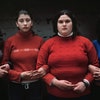“This is not the end,” Alessandra Sanguinetti promised in the last pages of her terrific 2010 book, The Adventures of Guille and Belinda and the
Sanguinetti met the girls as neighbors on farms near the one her father owned south of Buenos Aires, where the New York-born photographer spent her own childhood summers. She became the most appreciative audience for their dress-up games and dramas, many of which were clearly staged for her camera. But the bond of shared, make-believe adventures that Guille and Belinda forged as kids is tested as they grow up and apart. The new book deals with the way responsibility, romance, and domesticity redefine their relationship.
Following the international success of Elena Ferrante’s Neapolitan Novels, it’s not hard to find echoes of the young Lenu and Lila in Sanguinetti’s coming-of-age story. But if Guille and Belinda are seen together less and less as the new book tracks their changing lives, there’s no hint of the fraught rivalry and misunderstandings that gnawed away at Ferrante’s best friends. The “illusion of everlasting summer” may be more difficult to sustain when everyday life–including family gatherings, farm chores, and pregnancy–can no longer be re-imagined as a moment on a fantasy TV show. But the depth of the girls’ intertwined history is no illusion and they don’t need to be physically present to touch one another’s lives. We might miss the charming, conspiratorial playfulness of the first book, but the sequel is just as tender and far more intimate.
Alessandra Sanguinetti, from “The Adventures of Guille and Belinda and the Illusion of an Everlasting Summer”; (MACK, 2020). Courtesy the artist and MACK.
Throughout the project, Sanguinetti, a Magnum photographer, combines documentary and staged material without ever striking a false note. Working with what has become her extended family, the intimacy she captures–young lovers snuggling, a new mother breast-feeding–feels earned and authentic. And ordinary moments have a satisfying weight.
In the photograph above, Belinda (on the left) and Guille, both fifteen, link arms with their unseen cousins. Belinda has just dropped out of school and her parents were hovering, wondering why, which might explain her slightly distracted, introspective expression and Guille’s sympathetic seriousness, all contradicted by the enthusiasm of their bright red sweaters.
Not long after, Sanguinetti reports, Belinda met Pablo, the boy she went on to marry. Sanguinetti punctuates the book with photographs of canals and dusty roads leading off into the distance. Are they escape routes? Roads not taken? Maybe, but one of them ends in a rainbow, and you wouldn’t even have to leave the farm to get there.
Vince Aletti is a photography critic and curator. He has been living and working in New York since 1967. A contributor to “Aperture”, “Artforum”, “Apartamento” and “Photograph”, he co-wrote “Avedon Fashion 1944-2000”, published by Harry N. Abrams in 2009, and is the author of “Issues: A History of Photography in Fashion Magazines”, published by Phaidon in 2019.

